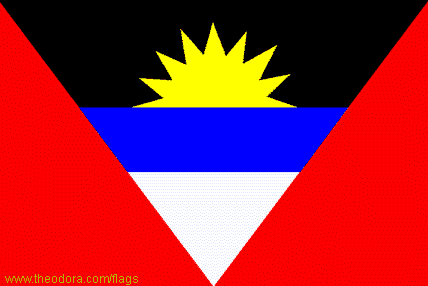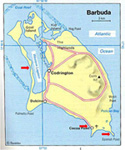 Barbuda April 13-16, 2010
Barbuda April 13-16, 2010

Click on the above thumbnail for a map during this time period
Barbuda is a land of contrasts. It has the kind of beaches that one
automatically associates with tropical islands, but it has very little of an
associated tourist-oriented infrastructure. Whereas its sister
island, Antigua, is checkered with fancy gated developments targeted at wealthy
Americans and Europeans, Barbuda is a sparsely populated island with only about
1600 human residents, and probably as many wild donkeys. Property on the
island is held communally -- outsiders may not purchase land; they may only
enter into lease agreements. It is a very low island; the "highlands"
along the northeast only reach about 125 feet above sea level. There
is a very large lagoon that stretches along the western portion of the island;
it lies just behind a very thin stretch of sand that presents perhaps the most
beautiful pink-sand beach in the Caribbean. At the northern end of Codrington Lagoon is one of the largest Magnificent Frigate bird rookeries in the
world, and this is attracting a steady if not mighty stream of visitors.
Coco Point and points east along the southern shore
Our first stop on this visit was to the anchorage at Coco Point. While anchored there we dinghied to the beach near the small guard house where a
very friendly man named George guards the property of the Coco Point Lodge
Hotel. We were joined by Chris and Yani (Magus) and Hunter and Devi
(Arctic Tern) for a walk along a stretch of the "main" road that runs east
toward Spanish Point.
|
|

|
|
Wallking down the beach toward the guardhouse
|
|

|
|
Another view of the gorgeous beach
|
|

|
|
"Scarecrow" marks the spot where the road can be accessed from the beach
|
|

|
|
Mighty puzzle: there are not big trees on Barbuda
|
|

|
|
Island is mostly flat, and in the south has many exposed patches of limestone
|
|
|
|

|
|
We veered off the road to walk east along the shore of Gravenor Bay ...
|
|

|
|
... which features limestone rather than sand
|
|

|
|
On the return trip the heel came off of Chuck's sandal -- here Hunter supplies an emergency application of Duct Tape ...
|
|

|
|
... but shortly thereafter the toe came loose as well
|
|

|
|
The "Barbuda Triangle" as seen on our return
|
|
|
|

|
|
While at Coco Point we had a VERY unusual occurence: clocking winds almost through 360 degrees
|
|
|
Frigate Rookery
On another day we all engaged a taxi driver to come out to Coco Point and
take us into the island's only town: the village of Codrington.
There we met with George Jeffrey, the "dean" of the tour guides that take
visitors to the Frigate rookery. Last year on our visit we had seen
a few hopeful males still sporting the huge red pouches on their breasts that
are used to attract a female; this year, only a few weeks later, there
were no pouches in evidence. Pouches or no, the rookery is still a
remarkable place to visit.
|
|

|
|
"Dean" of the Frigate tour guides: George Jeffrey
|
|

|
|
Chris, Yani and Devi look at birds and jelly fish
|
|

|
|
Besides birds, the rookery is "famous" for its "upside down" jelly fish ...
|
|

|
|
... which have plants (zoanthellae) growing on them
|
|

|
|
Another boat arrives at the rookery
|
|
|
|
|
|
|
|
|
|
|
|
|
|
|
|
|
Spanish Point/White Bay
As the shoreline proceeds west from Coco Point along Gravenor Bay, it changes
from limestone to sand, and the bay accordingly changes names to White Bay. On 4/15 the Barbuda Triangle moved from Coco Point to Spanish Point,
anchoring between the coral heads of White Bay. The next day, two legs of
the triangle (Arctic Tern and Tusen Takk II) went on a long hike
up the along the eastern shore. Not too far up, we found an interesting
campsite, and later, walking along a very-seldom-used vehicle track, we found a
cactus bearing fruit. The Terns promptly set to doing some
peeling, and we all got a taste. Not bad.
|
|

|
|
Barbuda Triangle is joined by a small French boat in White Bay
|
|

|
|
Wild horses behind the dunes along the eastern shore
|
|

|
|
Hammock at a "hidden" campsite
|
|

|
|
camp firesite
|
|

|
|
plastic tray suspended to provide storage place at the camp
|
|
|
|

|
|
scouring pad cached in a tree fork at the site
|
|

|
|
seen at several camp sites, this is probably a hanger for clothes
|
|

|
|
Eastern beach was totally deserted but certainly not litter-free
|
|

|
|
Stump washed ashore (and subsequently adorned by beach walkers)
|
|

|
|
Hunter constructs a tripod -- just "because"
|
|
|
|

|
|
Returning along the vehicle track behind the dunes...
|
|

|
|
... the Terns discover a cactus bearing fruit
|
|

|
|
This fruit ...
|
|

|
|
... fell off of this cactus
|
|

|
|
Devi peels ...
|
|
|
|

|
|
... and gets her hand very stained ...
|
|

|
|
... while Hunter avoids the problem
|
|

|
|
VERY surprising sprout out of the sand track
|
|

|
|
Ghost crab thinks he has hidden in the shadow
|
|
|
Return to Home Page
 Barbuda April 13-16, 2010
Barbuda April 13-16, 2010
 Barbuda April 13-16, 2010
Barbuda April 13-16, 2010